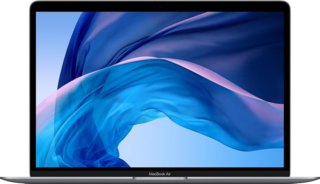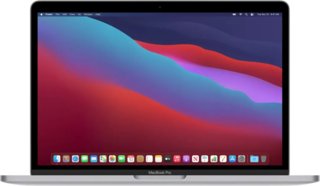Apple MacBook Air (2018) 13.3" Intel Core i5 vs Apple MacBook Pro (2020) 13.3" Apple M1
In selecting the Apple MacBook Air (2018) or the MacBook Pro (2020), various factors need consideration. Both feature a stylish 13.3" screen, 8GB RAM, and a generous 512GB SSD for storage, showcasing top-tier design and functionality.
The MacBook Air and MacBook Pro differ mainly in processing power. The MacBook Air features an Intel Core i5 processor, suitable for everyday use and boosting its portability. In contrast, the MacBook Pro runs on Apple's M1 chip, delivering exceptional speed and performance that power users will find impressive.
Choosing between these two impressive laptops depends on what matters most to you. For those who prioritize a lightweight build and a more budget-friendly option, the MacBook Air is an excellent choice. However, if your work involves heavy-duty tasks or creative projects that demand high performance, the MacBook Pro stands out with its superior capabilities.
System and application performance
Performance in popular 3D games
Viewing angle, color accuracy...
Ports, webcam and other interfaces
Potential battery life
Materials, durability and portability
Design Comparison
Size Comparison
In our comparison of the design elements in the Apple MacBook Air (2018) and the Apple MacBook Pro (2020), we identify key aspects that can greatly improve user experience, addressing various needs and preferences.
Size and Weight: The MacBook Air weighs slightly less at 3 pounds, while the MacBook Pro is slightly heavier at 3.1 pounds. This weight variance may seem small but can impact portability, particularly for students or professionals who are often on the go.
**Build Quality and Materials: *
Both laptops showcase Apple's renowned aluminum construction known for its premium look and lasting durability. The sleek metal finish not only adds elegance but also ensures reliable protection from daily wear and tear, making them versatile for use in different settings.
Ergonomics: The MacBook Air is slightly bigger at 12.8 x 8.9 x 0.7 inches compared to the MacBook Pro's 12 x 8.4 x 0.6 inches, potentially affecting user comfort based on their preference for compactness or screen size.
Keyboard and Connectivity: Both laptops feature a backlit keyboard for enhanced usability in dimly lit environments during long work sessions. The MacBook Air comes with traditional USB 3.0 ports, whereas the MacBook Pro includes Thunderbolt ports that provide quicker data transfers and expanded connectivity choices ideal for professionals using peripherals or high-speed devices.
Wireless Connectivity: Both laptops support different Wi-Fi standards, with the MacBook Pro offering Wi-Fi 6 (802.11ax) for enhanced speed and efficiency over the Wi-Fi 5 (802.11ac) on the MacBook Air.
Audio Features:
- Both laptops include stereo speakers and a socket for a 3.5mm audio jack, ensuring quality sound output for multimedia consumption or video conferencing needs.
Camera and Microphones:
- With front cameras and multiple microphones on both models, users can enjoy clear video calls or recordings without compromising audio quality.
Unique Features:
- The MacBook Pro stands out with its inclusion of a fingerprint scanner, enhancing security through biometric authentication for professionals handling sensitive data.
- The MacBook Pro also features AirPlay support, enabling seamless wireless streaming to external displays or speakers, a valuable addition for users seeking versatile connectivity options.
Students seeking a blend of performance and portability may find the MacBook Air's lightweight design attractive. For those in need of top-notch security and advanced connectivity, the MacBook Pro's fingerprint scanner and Thunderbolt ports offer valuable features. Both laptops feature high-quality construction, comfortable designs, and necessary functions to meet a variety of user needs.
Screen Comparison
| Apple MacBook Air (2018) 13.3" Intel Core i5 | Apple MacBook Pro (2020) 13.3" Apple M1 | |
|---|---|---|
| Resolution | HD | QHD |
| Screen Size | 13.3" | 13.3" |
When comparing the screen specifications of the Apple MacBook Air (2018) and the Apple MacBook Pro (2020), it's crucial to assess how these features affect user experience, particularly in activities such as gaming or professional graphic design. Let's explore these aspects without diverting into unrelated hardware specifications.
Screen Size:
- MacBook Air (2018): 13.3 inches
- MacBook Pro (2020): 13.3 inches
Both laptops feature the same screen size, offering a standard viewing experience without one having a significant advantage over the other in terms of screen space for multitasking or immersive content consumption.
Screen Resolution:
- MacBook Air (2018): 1440 x 900 px
- MacBook Pro (2020): 2560 x 1440 px
The MacBook Pro features a higher resolution, providing sharper image quality and more detail than the MacBook Air. This distinction becomes especially apparent when working on graphic design projects that demand accurate color representation and clarity.
Pixel Density:
- MacBook Air (2018): 128 ppi
- MacBook Pro (2020): 227 ppi
The MacBook Pro boasts a higher pixel density, providing sharper text and images for improved visual quality. This is especially valuable for tasks such as photo editing or video production that require attention to detail.
Display Technology:
- MacBook Air (2018): LED-backlit LCD
- MacBook Pro (2020): IPS LCD, LED-backlit
The MacBook Pro's IPS panel provides broader viewing angles and improved color accuracy compared to the standard LED-backlit LCD screen on the MacBook Air. This feature is especially beneficial for graphic designers or gamers who need uniform color representation from different perspectives.
Brightness:
- MacBook Air (2018): N/A
- MacBook Pro (2020): 500 nits
The MacBook Pro boasts a brightness level of 500 nits, perfect for outdoor use or well-lit environments. This feature guarantees clear visibility in bright settings, improving user comfort during long periods of use.
In summary, the MacBook Pro stands out as a preferred option for professionals and users seeking top-notch display quality due to its superior resolution, pixel density, display technology, and brightness. If visual clarity and color accuracy are crucial in your tasks or entertainment, the MacBook Pro's screen specifications offer a distinct edge over the MacBook Air.
Hardware Comparison
| Apple MacBook Air (2018) 13.3" Intel Core i5 | Apple MacBook Pro (2020) 13.3" Apple M1 | |
|---|---|---|
| CPU | Intel Core i5 | Apple M1 |
| RAM | 8GB | 8GB |
| Storage Size | 512GB | 512GB |
Comparing the hardware of the Apple MacBook Air (2018) and the Apple MacBook Pro (2020) reveals essential components that influence overall performance. Explore each laptop to assist in making a decision tailored to your needs.
Apple MacBook Air (2018)
- CPU: Intel Core i5 processor running at 1.8GHz
- RAM: 8GB
- Storage: 512GB SSD
- Max Memory Amount: 16GB
- CPU Speed: 2GHz (Turbo Clock Speed: 2.9GHz)
- Uses Flash Storage: Yes
Performance Impact: The Intel Core i5 processor delivers consistent performance for daily tasks and multitasking.
- 8GB of RAM enables efficient multitasking and seamless photo and video editing.
- The 512GB SSD storage provides quick boot times and fast application loading.
Apple MacBook Pro (2020)
- CPU: Apple M1
- RAM: 8GB
- Storage: 512GB SSD
- Memory Speed: 4266 MHz
- Semiconductor Size: 5nm
- Cores/Threads: 8 cores/8 threads
- Integrated Graphics: Yes
Performance Impact:
- The Apple M1 chip offers impressive performance with its integrated GPU for enhanced graphics capabilities.
- The advanced memory technology and architecture contribute to faster data processing.
- With a smaller semiconductor size, the MacBook Pro is more power-efficient and generates less heat.
Comparison Insights:
- *CPU & Performance: * The Intel Core i5 in the MacBook Air provides solid performance, but the Apple M1 chip in the MacBook Pro offers enhanced efficiency and superior performance for demanding tasks.
- Graphics & Memory: The M1 chip's integrated GPU and enhanced memory speed provide the MacBook Pro with a competitive advantage for multimedia tasks and graphic-intensive applications.
Efficiency & Heat Management: The smaller semiconductor size in the M1 chip makes the MacBook Pro more energy-efficient and thermally efficient compared to the older Intel processor in the MacBook Air.
Conclusion:
- For tasks such as multimedia editing or running heavy software, the Apple MacBook Pro (2020) with the Apple M1 chip is a better option due to its enhanced performance, improved graphics capabilities, and energy efficiency. On the other hand, if your computing needs are lighter and you're conscious of your budget, the Apple MacBook Air (2018) can still provide a dependable user experience for regular tasks.
Battery Comparison
| Apple MacBook Air (2018) 13.3" Intel Core i5 | Apple MacBook Pro (2020) 13.3" Apple M1 | |
|---|---|---|
| Battery Life | 12 hours | 17 hours |
Battery Comparison: Apple MacBook Air (2018) vs Apple MacBook Pro (2020)
When choosing between the Apple MacBook Air (2018) and the Apple MacBook Pro (2020), one key factor to consider is battery life. Let's compare the battery specifications of these two laptops:
Apple MacBook Air (2018) 13.3" with Intel Core i5 processor, 8GB RAM, and 512GB SSD:
- Battery Life: 12 hours
- Sleep And Charge USB Ports: True
- Magsafe Power Adapter: True
Apple MacBook Pro (2020) 13.3" with Apple M1 Chip, 8GB RAM, and 512GB SSD:
- Battery Life: 17 hours
- Sleep And Charge USB Ports: True
The Apple MacBook Pro (2020) surpasses the MacBook Air (2018) in battery life, offering up to 17 hours on a single charge compared to the Air's 12 hours. This extended battery life allows users of the MacBook Pro more time for wireless use before having to recharge.
Both laptops include Sleep And Charge USB Ports, enabling device charging while the laptop is in sleep mode. The MacBook Air exclusively features a Magsafe Power Adapter with a magnetic connection for convenient and secure charging.
For users needing extended battery life, the MacBook Pro offers longer usage periods, allowing for increased productivity without frequent interruptions for recharging.
In conclusion, for extended battery life on your laptop, consider the Apple MacBook Pro (2020) which offers an impressive 17-hour battery compared to the Apple MacBook Air (2018).
Verdict
Why Apple MacBook Air (2018) 13.3" Intel Core i5?
- If you prioritize budget-friendliness and lightweight design, choose the Apple MacBook Air (2018) with Intel Core i5.
- The MacBook Air (2018) offers traditional USB ports which may be more convenient for some users.
- For tasks that do not require cutting-edge performance or advanced graphics capabilities, the MacBook Air (2018) remains a reliable option.
Why ?
- Apple MacBook Pro (2020) features the powerful Apple M1 chip for enhanced performance.
- The MacBook Pro boasts a longer battery life of up to 17 hours compared to the MacBook Air's 12 hours.
- Enhanced graphics capabilities with the integrated GPU on the MacBook Pro provide better multimedia and graphic-intensive task performance.
Similar comparisons
- Apple MacBook Air (2017) 13.3" Intel Core i7 vs Apple MacBook Pro (2017) 13" with Touch Bar and Touch ID / Intel Core i5 256GB
- Apple MacBook Air (2017) 13.3" Intel Core i5 256GB vs HP Envy x360 13 (2020) AMD Ryzen 5 4500U
- Apple MacBook Air (2017) 13.3" Intel Core i5 128GB vs Apple MacBook Pro (2016) 13" with Touch Bar and Touch ID
- Apple MacBook Air (2017) 13.3" Intel Core i5 128GB vs Apple MacBook Pro (2015) 15"
- Acer Chromebook 11 N7 (C731) 11.6" Intel Celeron N3060 vs Asus Chromebook Flip C302 12.5" Intel Core m3-6Y30

